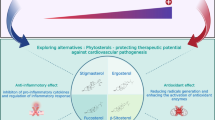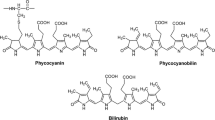Abstract
The present study investigated the anti-hyperlipidemic proprieties of a natural alkaloid, gelsemine, in a high-fat-fed rabbit model. Animals were randomly divided into five groups and fed normal diet, hypercholesterolemic diet (1 % cholesterol), or hypercholesterolemic diet (1 % cholesterol) supplemented with gelsemine (1, 5, or 25 mg/kg). After 60 days, serum concentrations of total cholesterol (TC), LDL-C, HDL-C, triglycerides, apolipoproteins A and B, SGOT, SGPT, glucose, and insulin were measured in all experimental groups. Hypercholesterolemic diet resulted in significantly elevated levels of TC, TG, LDL-C, SGOT, and SGPT, and reduced HDL-C compared to the normocholesterolemic diet group. Gelsemine treatment significantly improved lipid profile parameters, affected by hyperlipidemia, while having no effect on the levels of apolipoproteins, glucose, and insulin. Furthermore, gelsemine treatment decreased hyperlipidemia-induced oxidative stress in a dose-dependent manner, as indicated by the increased activity of superoxide dismutase and catalase, and reduction in serum nitric oxide, and malondialdehyde concentrations in hyperlipidemic animals that received gelsemine supplementation. Dietary supplementation with gelsemine may, therefore, reverse the effect of the lipogenic diet on lipid profile and hepatic enzymes in hyperlipidemic rabbits, and protect tissues from oxidative stress, caused by high-fat diet.




Similar content being viewed by others
References
Dong, H., & Czaja, M. J. (2011). Regulation of lipid droplets by autophagy. Trends in endocrinology and metabolism: TEM, 22, 234–240.
Cole, L. K., Vance, J. E., & Vance, D. E. (2012). Phosphatidylcholine biosynthesis and lipoprotein metabolism. Biochimica et Biophysica Acta, 1821, 754–761.
Patschan, S., Chen, J., Polotskaia, A., et al. (2008). Lipid mediators of autophagy in stress-induced premature senescence of endothelial cells. American Journal of Physiology Heart and Circulatory Physiology, 294, H1119–H1129.
Della Corte, C., Alisi, A., Iorio, R., et al. (2011). Expert opinion on current therapies for nonalcoholic fatty liver disease. Expert Opinion on Pharmacotherapy, 12, 1901–1911.
Baynes, J. W. (1991). Role of oxidative stress in development of complications in diabetes. Diabetes, 40, 405–412.
Pieper, G. M., Jordan, M., Dondlinger, L. A., et al. (1995). Peroxidative stress in diabetic blood vessels. Reversal by pancreatic islet transplantation. Diabetes, 44, 884–889.
Bullon, P., Newman, H. N., & Battino, M. (2014). Obesity, diabetes mellitus, atherosclerosis and chronic periodontitis: A shared pathology via oxidative stress and mitochondrial dysfunction? Periodontology, 2000(64), 139–153.
Hortelano, S., Dewez, B., Genaro, A. M., et al. (1995). Nitric oxide is released in regenerating liver after partial hepatectomy. Hepatology, 21, 776–786.
Liu, M., Shen, J., Liu, H., et al. (2011). Gelsenicine from Gelsemium elegans attenuates neuropathic and inflammatory pain in mice. Biological and Pharmaceutical Bulletin, 34, 1877–1880.
Liu, M., Huang, H. H., Yang, J., et al. (2013). The active alkaloids of Gelsemium elegans Benth. are potent anxiolytics. Psychopharmacology (Berl), 225, 839–851.
Dong, S. F., Hong, Y., Liu, M., et al. (2011). Berberine attenuates cardiac dysfunction in hyperglycemic and hypercholesterolemic rats. European Journal of Pharmacology, 660, 2–3.
Zhang, H., Wei, J., Xue, R., Wu, J. D., et al. (2010). Berberine lowers blood glucose in type 2 diabetes mellitus patients through increasing insulin receptor expression. Metabolism, 59, 285–292.
Genet, S., Kale, R. K., & Baquer, N. Z. (2002). Alterations in antioxidant enzymes and oxidative damage in experimental diabetic rat tissues: effect of vanadate and fenugreek (Trigonellafoenum graecum). Molecular and Cellular Biochemistry, 236, 7–12.
Marklund, S., & Marklund, G. (1974). Involvement of the superoxide anion radical in the autoxidation of pyrogallol and a convenient assay for superoxide dismutase. European Journal of Biochemistry, 47, 469–474.
Aebi, H. (1984). Catalase in vitro. Methods in Enzymology, 105, 121–126.
Bradford, M. M. (1976). A rapid and sensitive method for the quantitation of microgram quantities of protein utilizing the principle of protein-dye binding. Analytical Biochemistry, 72, 248–254.
Vornoli, A., Pozzo, L., Della Croce, C. M., et al. (2014). Drug metabolism enzymes in a steatotic model of rat treated with a high fat diet and a low dose of streptozotocin. Food and Chemical Toxicology, 70, 54–60.
Yang, S. J., Je Lee, W., Kim, E. A., et al. (2014). Effects of N-adamantyl-4-methylthiazol-2-amine on hyperglycemia, hyperlipidemia and oxidative stress in streptozotocin-induced diabetic rats. European Journal of Pharmacology, 736C, 26–34.
Wang, L., Tian, W., Uwais, Z., et al. (2014). AGE-breaker ALT-711 plus insulin could restore erectile function in streptozotocin-induced type 1 diabetic rats. Journal of Sexual Medicine, 11(6), 1452–1462.
Acknowledgments
This Project is supported by: 1. Zhejiang Provincial Natural Science Foundation of China (Grant No. Y2080374); 2.The National Natural Sciences Foundation of China (Project for Young Scientists, No. 30800999); 3. Zhejiang Provincial Natural Science Foundation of China (Project for Young Scientists, No. LQ13H070001).
Conflict of interest
The authors have declared that no competing interests exist.
Author information
Authors and Affiliations
Corresponding author
Rights and permissions
About this article
Cite this article
Wu, T., Chen, G., Chen, X. et al. Anti-hyperlipidemic and Anti-oxidative Effects of Gelsemine in High-Fat-Diet-Fed Rabbits. Cell Biochem Biophys 71, 337–344 (2015). https://doi.org/10.1007/s12013-014-0203-2
Published:
Issue Date:
DOI: https://doi.org/10.1007/s12013-014-0203-2




